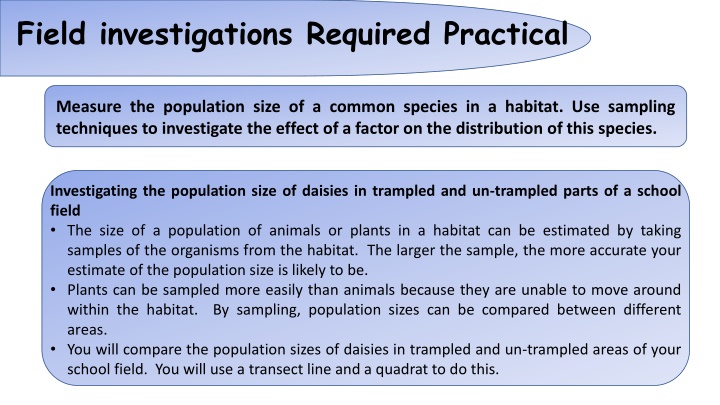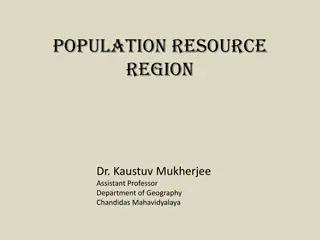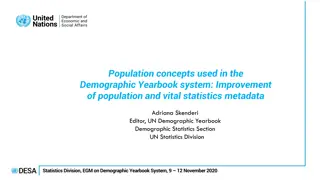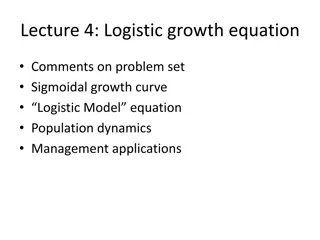Population Size Investigation of Daisies in School Field
This practical field investigation involves measuring the population size of daisies in both trampled and un-trampled areas of a school field. Using sampling techniques such as transect lines and quadrats, the study aims to compare the distribution of daisies in the different areas. Factors like reliability and reproducibility of results are discussed, highlighting the importance of accurate measurements for scientific investigations.
Download Presentation

Please find below an Image/Link to download the presentation.
The content on the website is provided AS IS for your information and personal use only. It may not be sold, licensed, or shared on other websites without obtaining consent from the author.If you encounter any issues during the download, it is possible that the publisher has removed the file from their server.
You are allowed to download the files provided on this website for personal or commercial use, subject to the condition that they are used lawfully. All files are the property of their respective owners.
The content on the website is provided AS IS for your information and personal use only. It may not be sold, licensed, or shared on other websites without obtaining consent from the author.
E N D
Presentation Transcript
Field investigations Required Practical Measure the population size of a common species in a habitat. Use sampling techniques to investigate the effect of a factor on the distribution of this species. Investigating the population size of daisies in trampled and un-trampled parts of a school field The size of a population of animals or plants in a habitat can be estimated by taking samples of the organisms from the habitat. The larger the sample, the more accurate your estimate of the population size is likely to be. Plants can be sampled more easily than animals because they are unable to move around within the habitat. By sampling, population sizes can be compared between different areas. You will compare the population sizes of daisies in trampled and un-trampled areas of your school field. You will use a transect line and a quadrat to do this.
Field investigations Required Practical Measure the population size of a common species in a habitat. Use sampling techniques to investigate the effect of a factor on the distribution of this species . 1. Put the 30 m tape measure across a trampled area of the school field to form a transect line. 2. Put the 1 m2 quadrat against the transect line. One corner of the quadrat should touch the 0 m mark on the tape measure. 3. Count the number of daisy plants within the quadrat. 4. Record the number of daisies counted within the quadrat 5. Move the quadrat 5 m up the transect line and count the number of daisy plants again. Record in the table. 6. Continue to place the quadrat at 5 m intervals and count the number of daisy plants in 7. each quadrat. 8. Calculate the mean number of daisy plants per m2 for the trampled area. 9. Move the 30 m tape measure to an un-trampled area of the school field to form the new transect line. 10. Repeat steps 2 7 for the un-trampled transect line. 11. Compare the population size of daisies in the trampled and un-trampled areas of the field. Distance along the transect line in m Number of daisy plants per 1 m2 quadrat Trampled Un-trampled 0 5 10 15 20 25 30 Mean number of daisy plants per m2
Measure the population size of a common species in a habitat. Use sampling techniques to investigate the effect of a factor on the distribution of this species . Reliability & Reproducibility Reliability: the degree to which the result of a measurement, calculation, or specification can be depended on to be accurate. Task 1. How do we know if results are reliable? 2. How do we know if results are reproducible? 3. How could we improve our method to make it more reliable & reproducible? Reproducibility : The ability of an entire experiment or study to be duplicated, either by the same researcher or by someone else working independently. Reproducing an experiment is called replicating it.
Measure the population size of a common species in a habitat. Use sampling techniques to investigate the effect of a factor on the distribution of this species. Aim The size of a population of animals or plants in a habitat can be estimated by taking samples of the organisms habitat. You will compare the population sizes of daisies in trampled and un-trampled areas of your school field. You will use a transect line and a quadrat to do this. Example Results from the How to look at the results Take 10 samples from each area Average them out Multiply by the total area Compare results
Measure the population size of a common species in a habitat. Use sampling techniques to investigate the effect of a factor on the distribution of this species . Enzymes Required Practical Things to remember when answering 6 mark exam questions: 1.Try and remember everything you can about what the question is asking before you start answering it 2.Make at least 6 points 3.Write in full sentences starting with capital letters and ending with full stops 4.Try and answer the question in around five minutes 5.Check your answer to make sure you have not left anything out 6.Remember to use key words when appropriate























